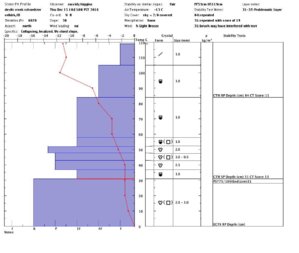Hello all,
i went just out of bounds off schweitzer today and dug a pit. the snow on top is light powder and great skiing. the area i dug had about 119cm of snow and i spotted two layers worth noting, the first is down about 35cm and is where the snow gets a little denser, it was hard to get a good look at how it was reacting in a compression test because the snow above was so light it was sloughing off the column. I think the thing to note about this layer is that it could become reactive if we get more snow on it or if wind loading occurs so watch out for wind slabs in loaded areas.
The other layer of concern was 31cm up from the ground underneath a kind of crust sandwich that looked like it was from the thanksgiving snow, it was a 1 finger density layer of faceting rounds sandwiched between layers of pencil to knife density melt forms and it reacted to to a compression test at 13 taps with a sudden collapse and a propagation saw test 75/100. no results with a ECT and i think thats because the decomposing crust above it is bridging the layer for now, but it is something to keep in mind throughout the season because if it goes it will go big.
All in all a short fun day with awesome low angle skiing. have fun and be safe out there!
i went just out of bounds off schweitzer today and dug a pit. the snow on top is light powder and great skiing. the area i dug had about 119cm of snow and i spotted two layers worth noting, the first is down about 35cm and is where the snow gets a little denser, it was hard to get a good look at how it was reacting in a compression test because the snow above was so light it was sloughing off the column. I think the thing to note about this layer is that it could become reactive if we get more snow on it or if wind loading occurs so watch out for wind slabs in loaded areas.
The other layer of concern was 31cm up from the ground underneath a kind of crust sandwich that looked like it was from the thanksgiving snow, it was a 1 finger density layer of faceting rounds sandwiched between layers of pencil to knife density melt forms and it reacted to to a compression test at 13 taps with a sudden collapse and a propagation saw test 75/100. no results with a ECT and i think thats because the decomposing crust above it is bridging the layer for now, but it is something to keep in mind throughout the season because if it goes it will go big.
All in all a short fun day with awesome low angle skiing. have fun and be safe out there!

